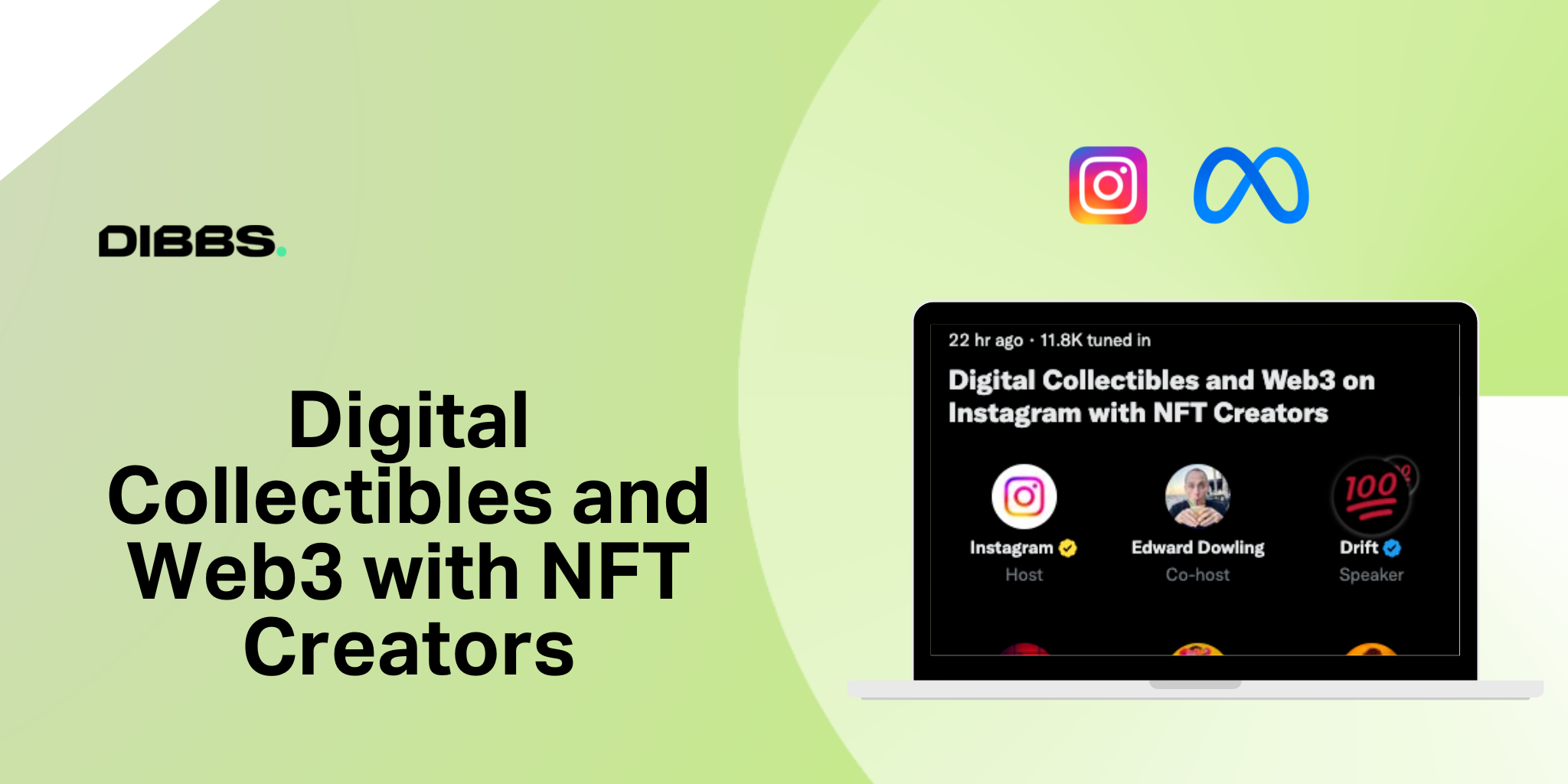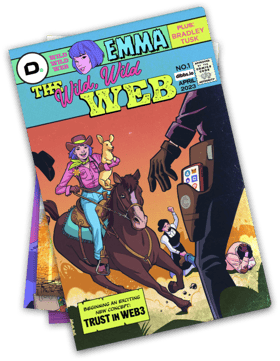Digital Collectibles and Web3 with NFT Creators by Instagram

Yesterday, Instagram hosted a Twitter Space revolving around all things NFT, digital collectibles, creators’ experiences and the future of the metaverse with four NFT creators who participated in Instagram's minting platform. What we thought was the most compelling part of the conversation was surrounding the subject of NFT adoption and utility, two things that are incredibly important to us at Dibbs.
Edward Dowling: What's the change that you've witnessed in the space?
Monaris: I think NFTs are a turning point because it gives everyone a somewhat equal chance, if that makes sense. It doesn't matter how many followers you have. This technology allows artists to create bodies of work, put them on the market and create a direct peer-to-peer relationship with the people who collect your work. It's that simple. We don't need galleries anymore to help sell our work. No middle man to complete transactions, and it's pretty much transparent. And then there's the royalties aspect of it where artists can get paid every time the work gets results. That's something that we've never seen before, and that's something I think that it's very important to note.
Ed: If you have any tips for buyers, how do you stay safe in this space? The elephant in the room, of course, crypto does have a reputation that there is fraud. Even though we have all of these amazing things happening, there are bad actors in this space. How can people protect themselves? How can they spot bad projects or red flags when they're trying to make their first kind of purchases and entrances into the space.
Roberto Nickson: Definitely try to find your community that you can trust in this space. It's been sort of instrumental in Metav3rse and that's exactly what we've been just trying to protect everybody and beyond. On Metav3rse, on Instagram as well is just space around protecting people. There almost should be some sort of like a security course or something where people that are onboarded into the space can really research cuz it's almost like a rite of passage in this space that you will get got eventually when you start participating. And so if you don't do the research beforehand, I mean, it's almost like an inevitability. And so really, really just doing your homework, the five, 10 hours. Gary Vee likes to say the 50 hours of homework, and I tend to agree with that. Align yourself with people that you can trust.
Subscribe to get our best content in your inbox
By clicking “Submit” you agree to Dibbs
Privacy Policy and
consent to Dibbs using your contact data for newsletter purposes.

Ed: You are the perfect person to help, given your role in the space as educator-in-chief for Web3. We just talked a little bit about this, some of the challenges in the space, but what do you all see as the single biggest challenge either you are personally facing or that you see the ecosystem as a whole facing?
Sara Baumann: Right now we still have an ecosystem that has a boatload of jargon and it is certainly a friction full space still. The barrier to entry for a lot of people is still quite high. It requires a lot of technical knowledge to get into the space, and it also requires a lot of aggregation of materials whenever it comes to learning. Like Roberto was saying a minute ago, it'd be great if there was a course for people to take that would allow them to learn the dos and don'ts of the space really quickly. But a lot of times when people jump in, it's a lot of information all at one time, and that information is scattered about the entire Web3 verse. The need to aggregate all of that information into one place would very much lower the barrier. That's probably the greatest point of friction that we're facing right now, is that it's still very information and jargon heavy and it's not quite streamlined just yet.
Drift: We have to think about financial barriers to entry, too. Not everybody (A) knows how to buy ETH or cryptocurrency, but (B) not everybody has the money to get started for minting a project, or whatever. As we continue to develop and hopefully push for more equitable barriers to entry, that would be good. Because this is a very niche space still, there's a tendency for, "This is us over here in Web3 and here's the rest of you guys in Web2," and it can be very isolating for outsiders looking in because I don't wanna say it's superiority of, "We're in the future," but it's kind of like, "We don't need you guys anymore." I don't think that could be any more wrong. There ought to be a very open arms approach to mainstream adoption and the recognition of the fact that 99.9% of the world is still not here and it's going to take time for them to get here. Just don't forget about the rest of the world and life outside of the space. Sometimes I feel like there is a vacuum and people get vacuumed into just thinking about this space 24/7. It's more harmful than it is good. I am excited about the technology and whatnot and it is already changing the world and well, people from now said are kinda like, “I can't even relate to that. I don't know what you're talking about." There's life outside of that screen you're on, so, that's a very big deal.
Ed: It kind of feels like its own separate world and it's kind of like a niche community right now. How do you see NFTs evolving in the future? How do you see the going from here? We've kind of got them for digital art, we're starting to see communities built around them and like that merging of physical and digital. Where do they go? What does the next couple of years look like?
Drift: Well, (A) brands like Instagram getting involved is a huge deal. Just like Roberto was saying, it is huge seeing brands get involved, but also the simplification of them, because to the outside world, it sounds dumb, but it's monkey pictures and all these different things that the utility of what NFTs can be has not fully been shown to the world yet. In a couple of years, your favorite creator might be minting on Instagram and there will also be built in utility to that NFT you buy and now you have access to their merger or whatever. And there's going to be so many things that unfold from here, right? But breaking it down to more simple things outside of PFP projects, involving it more with art is a very, very big thing, and showing people that this is not just some lofty outside world that you're now stepping into. It's something that you've been doing for a long time, just probably subconsciously on the internet and that you're just now stepping into this. So I don't know if I have a good answer for where it's going to go, but the more big brands get involved, the more simple everyday people can start to integrate and use NFTs, the easier it's going to be. And the more we move away from strictly PFP culture is going to be heavily impactful on where this goes.
Sara: As Drift was talking, I was like, “Starbucks!” We're starting to see, like he said, more and more mainstream brands that are coming into the space that are utilizing NFT technology, whether it be for membership or loyalty programs or even like high-end brands that are utilizing NFTs to verify that a luxury purse is in fact the luxury purse brand that you purchased. We're starting to see NFTs being utilized in a multitude of ways outside of just art – which, of course, for art is fantastic – but I also think that this space is so rapidly evolving. There's so many unique brains in the space. There's backgrounds of individuals from finance, from tech, from creative, from art, you name it. Because there is such a multitude of big brains from so many different backgrounds and avenues, we're developing a lot of really interesting things that are really rapid cadence. It's hard to truly quantify where NFTs will in fact go and to be right about it. It's kind of like the 1990s, whenever the internet was coming about and people were trying to get an idea of what the internet would be 20 years from now and like 90% of those opinions were wrong. Between NFTs and blockchain technology we're going to start seeing it everywhere. The friction to utilize it will probably decrease pretty significantly. I anticipate that we'll be utilizing blockchain and NFTs so much in our daily lives in the future that we won't even realize that we're actually doing it.
If you are a person who is confused about Web3 jargon, check out our ultimate Web3 glossary. You can even submit your own jargon and we'll explain it for you!

